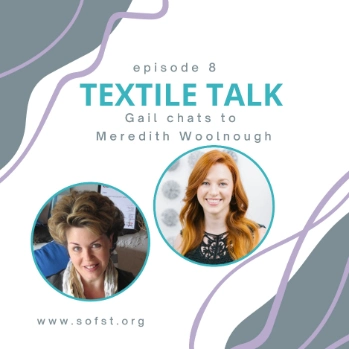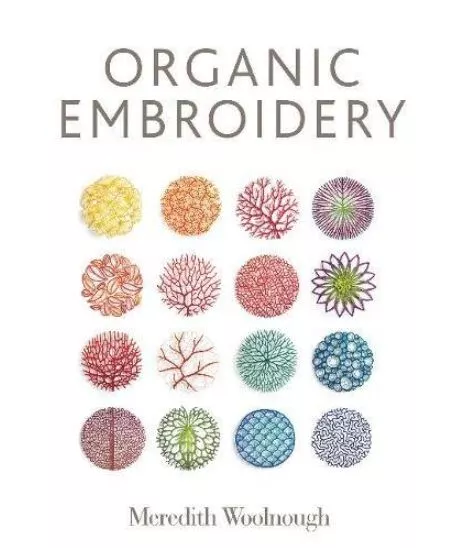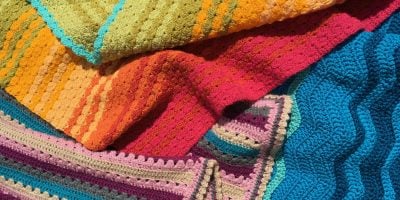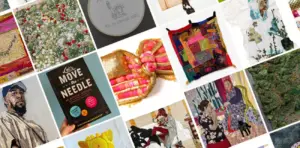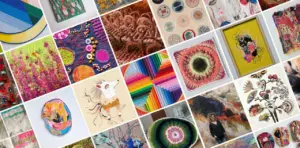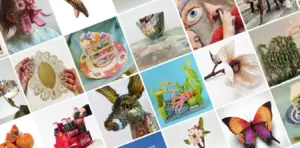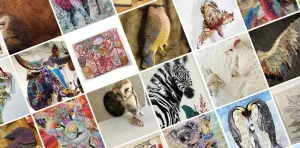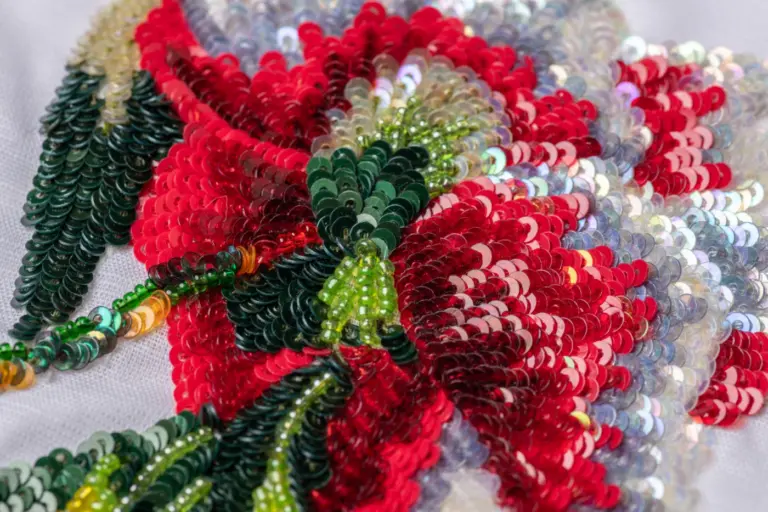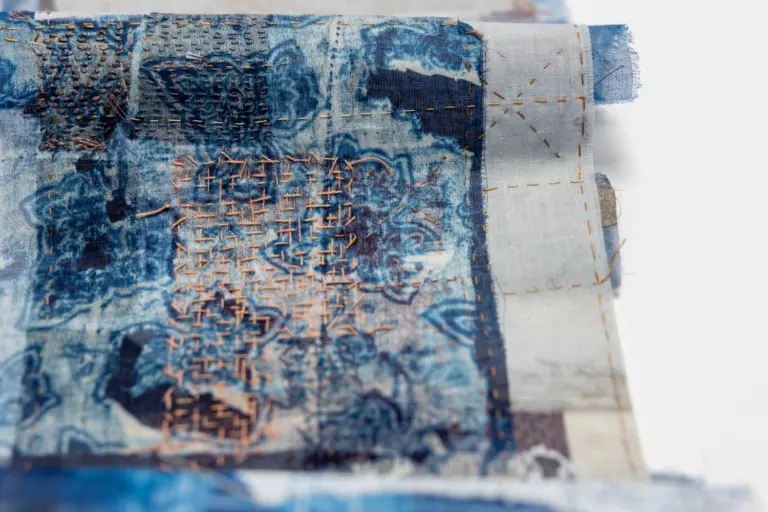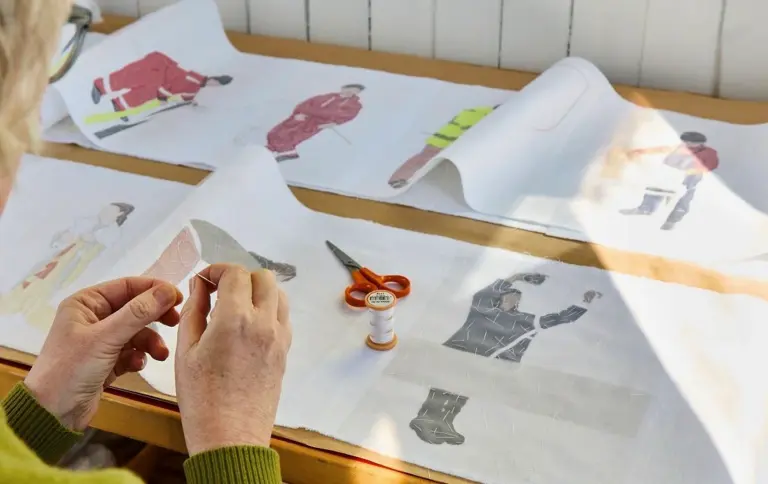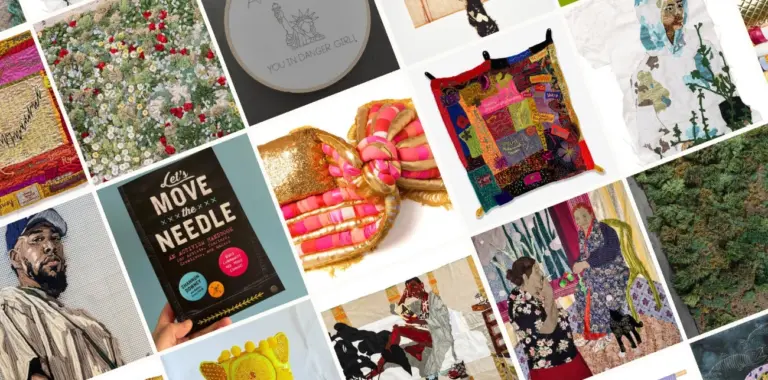Originally published November 27, 2019 and updated in September 2023.
Meredith Woolnough is an internationally acclaimed, award winning artist and author from Newcastle, Australia. Her work is held in public, private and corporate collections worldwide.
Inspired by the patterns, structures and shapes found in plants, coral, cells and shells Meredith’s embroideries represent both the robust beauty and elegant fragility of life. Specialising in open work embroidery, she often displays her work in shadowboxes – like preserved specimens – so that people can study the intricate beauty and detail of her pieces.
Back in 2019 we spoke with Meredith to learn more about her technique, style and inspiration, but now you also have the chance to listen to our latest podcast with Meredith Woolnough. Or you can read the transcript below while perusing some of her beautiful work.
Textile Talk with Meredith Woolnough
Listen to the podcast now or read through the transcript below.
Textile Talk with Meredith Woolnough
Transcription
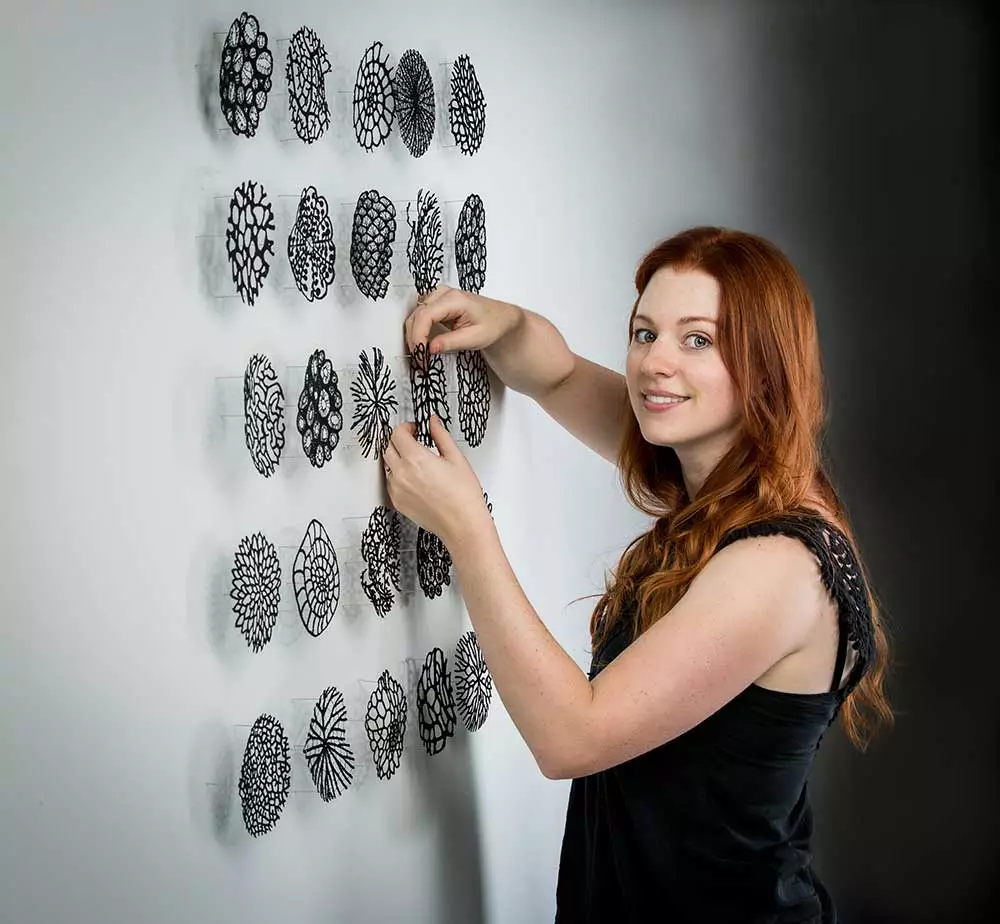
Joining me today is Meredith Woolnough, who is a professional artist working out of her studio in Newcastle, Australia. She’s best known for her Sculptural Embroideries, which are an exploration of art, science, and nature. The embroideries are created using a unique freehand embroidery technique that utilizes a domestic sewing machine and a fabric that dissolves in water.
The work explores the beauty and fragility of nature, sparking a sense of wonder and appreciation of the natural world. Meredith believes that the deeper our appreciation for the aesthetics of nature, the more eager we are to immerse ourselves in it and conserve it.
Meredith holds a BFA Bachelor of Fine Arts from the University of New South Wales, a Master’s of Teaching from the University of Sydney and a Bachelor of Natural History. Illustration from the University of Newcastle she has exhibited and sold her work worldwide, is the author of two books. The first is Organic Embroidery that was published in 2018, and the most recent, published this year is entitled The Hundred Embroideries Project. Meredith teaches both in person and online.
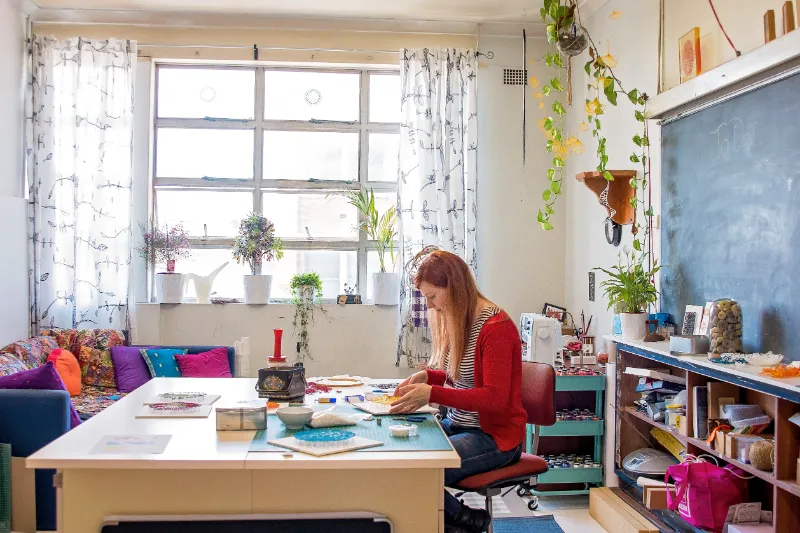
Gail: It's lovely to welcome you to the podcast. Thank you so much for agreeing to do this. And I guess the first thing that I'd like to ask if I could is how and when did you first start to stitch? Could you give us a little bit of perhaps an elevator pitch as to how that came about?
Meredith: Sure. Well, also, thank you very much for having me. It is lovely and quite an honor. So when did I first start to stitch? So I’ve dabbled with stitching probably my whole life, but I really didn’t take it seriously until the final honors year of my university degree. So I studied fine arts straight out of high school. I was very young and fresh, and I ended up majoring in textiles because it was an area that I really didn’t know very much about, and I was really interested in it, and it seemed really broad.
There were all these different, amazing things I could explore. And it wasn’t really until I did that final year, like a fourth extra year, which is basically a year of focused studio practice within the university. And I decided to work with freehand machine embroidery on water soluble fabric because I just thought that was a really fascinating combination of technique and material. And I’d been introduced to freehand machine embroidery through the degree, but just sort of really basic dabbling. And I sort of thought it was a really cool way to draw.
I thought it was a great idea to draw with your sewing machine and draw with threads. I thought that was really fun, but didn’t explore it too much until I had that honors ear opportunity. And then when I found out about water soluble fabric, well, that just blew my mind. Because then I realized that I could do my drawing with my sewing machine onto this fabric that was a temporary surface for my embroidered drawing. And then I could remove the fabric, completely, wash it away, and then I’d just be left with that stitched drawing, a thing that I’d made entirely from thread. And I just thought that had so much creative potential.
So I sort of threw myself into that, gave myself that luxurious year to play and stitch and make all the mistakes. And that was really when I fell in love with stitching, and I fell in love with free motion embroidery, specifically on water soluble fabric. And that’s where it all began. And that was when was that? 2006 was the year I did my honors year. So, yeah, a good 16 or 17 years ago now and still going with it. Still love it.
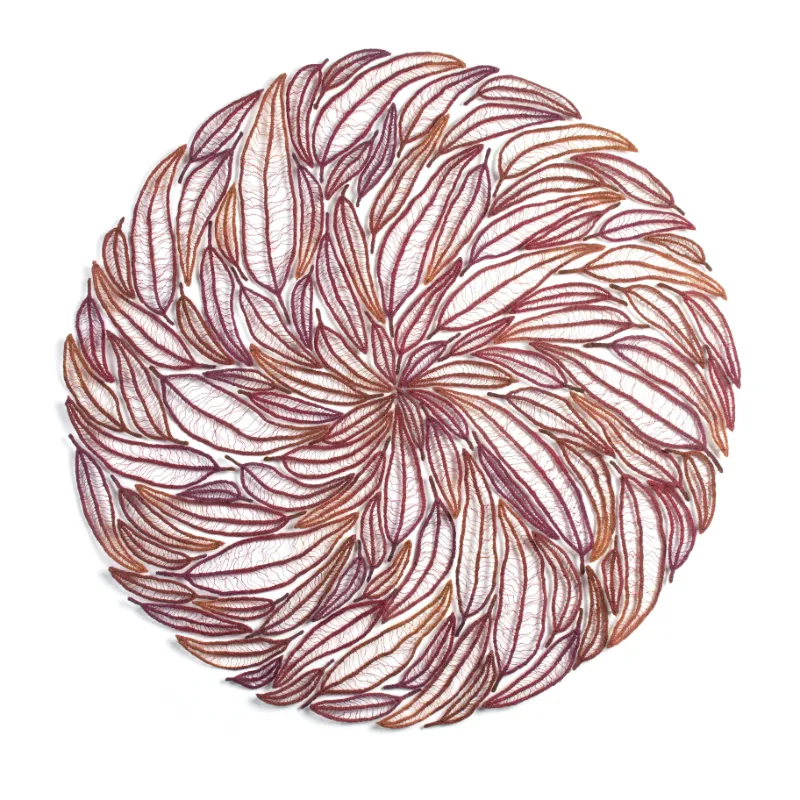
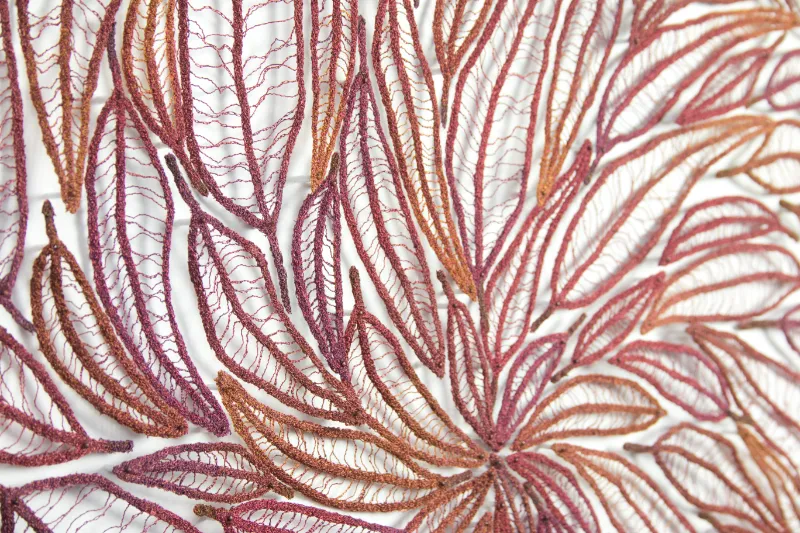
Gail: Fantastic. Can I just sort of coming from that, can I ask you what sort of machine you use?
Meredith: Yeah, that’s a great question because people always see my work and think it’s done on a fancy embroidery machine or some huge, expensive thing that does all the work and the stitching for me, but that’s not the case.
So freehand machine embroidery, or it’s also probably more commonly referred to as free motion embroidery, is essentially the same as machine darning. And when you do that, you basically just take a regular domestic sewing machine. You turn off all the settings so it’s just that needle going up and down so that you can move the fabric around that needle. So freehand or free motion work is really just fancy darning. So as a result, you can just do it on a standard domestic machine. And I first started on a very basic mechanical machine. I still have it. It’s older than I am. It was an ex school machine, a little bit worse for wear when I got it, but it sewed beautifully, and that’s where I started and that’s where a lot of people start.
So you don’t need a fancy machine. I have since upgraded and have some bigger and smoother models, and I also work on a long arm machine a lot of the time in my studio, and most people use those for quilting, but all they do is straight stitch free motion work, so they’re absolutely perfect for what I do. So I have that big long arm that I do most of my work on, unless I need a zigzag stitch, and then I need to jump back to one of the domestic machines.

Gail: And there's a little bit of a catch with zigzag stitch, isn't there, in free machine embroidery? If you don't underpin it properly, it can all unravel.
Meredith: Oh, yeah. Well, that’s sort of the secret to any of this kind of embroidery, particularly when working on water soluble fabric. It’s got to be well connected. You’ve got to really understand your structure and how your stitches are going to behave. Otherwise, they’re going to do all kinds of crazy and disappointing things. When you take that base fabric away.
Gail: I suppose that if you understand what they do, you can use that to your advantage, perhaps a little bit.
Meredith: Absolutely. And then you can start to push it and try new things and try new directions and see how far you can go with it. That’s one of the things that I love about it, because, as I said, I see this as just a way to draw, and there’s so many ways that you can do a drawing, and then this is a three dimensional structural drawing. So endless creative possibilities.
Gail: Absolutely. So, again, just sort of looping back a little bit. Water soluble fabric. There are so many different types out there. Do you have a preference?
Meredith: Yes, I do have a preference. So there’s really probably two main types of water soluble fabric that you’ll encounter. So there’s the clear film plasticky variety, which sort of looks like a sheet of plastic that’s commonly used, and some artists use it and love it, but I really don’t like that variety. I find it really difficult to work with, really difficult to stitch onto without tearing or stretching, and also really hard to wash away. So that’s not my choice.
The one that I prefer to work with is often referred to as a washable web variety of fabric. It’s generally white in colour, and it looks like interfacing. It looks like a lightweight interfacing. And there’s lots of different brand names, but they’re all pretty much the same. And that’s the one I prefer. I find it to be sturdier and stronger, and it also dissolves so much faster. So I can really control the dissolving process, and that’s really important for me. If I’m working sculpturally with my work, I really need to know what’s going on with that washing away moment.
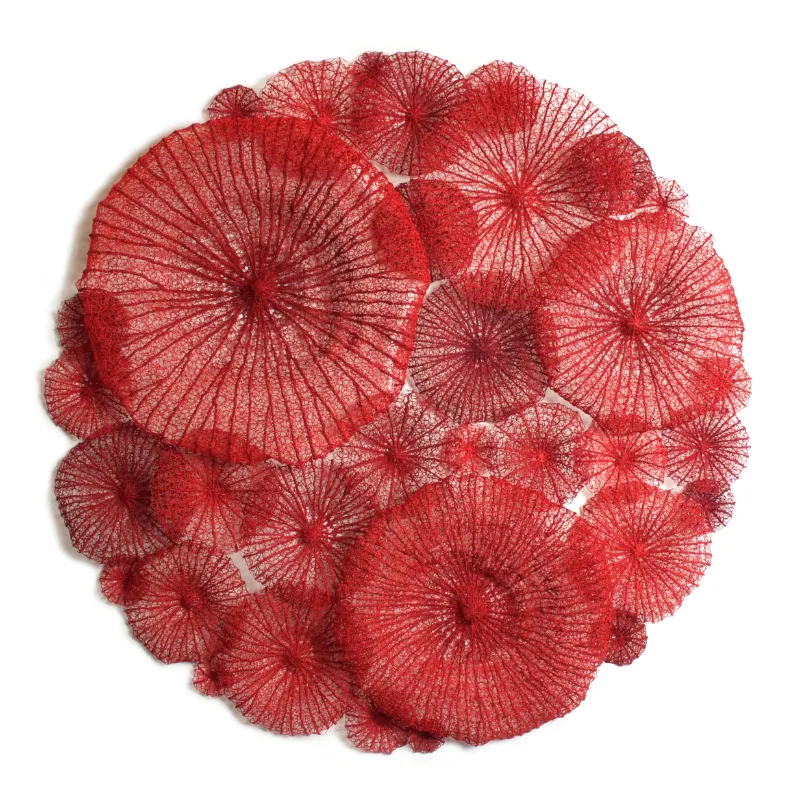
Gail: I know that with the sort that is almost like a glue, that clear sheet that you were describing, many people leave some residue of that in when they're perhaps forming a three dimensional shape to help it keep its shape. Are you able to do the same with the washable web variety?
Meredith: Yeah, absolutely. And that’s definitely something that I do as well. And it’s about finding the balance. You want to keep enough of the fabric in that you can get that molding ability and that glue-like effect, but you’ve got to also make sure that you don’t leave it on the surface of your work, because otherwise you’ll get that gluey residue reheartening. It sort of looks like a snail’s trail all over your work. So it’s about finding the right point with your dissolving to get the sculptural effects without the evidence of the glue.
Gail: Yes, indeed. Looking at the pieces that you do, they are extremely precise, I think it would be fair to say. How do you dry them so that they retain their shape quite simply, really.
Meredith: When they’re wet, they’re malleable. If you’ve left the right amount of water soluble fabric in whatever shape they’re in, when you dry them in that shape, they’ll stay in that shape. So I can create molds, just things that I can drape them in over or on, or if I want very specific shapes.
You can use things like styrofoam shapes and stretch them and pin them onto them, really anything’s. A mold, once you start looking, it’s all just about getting it in the shape you want. You’ve also got to be realistic. Of course, it’s still made of thread, and although there is gluey properties to it, it’s not going to harden like steel. It’s going to be a flexible product. So you do need to be sort of realistic and work within the realms of physics. But you can get some really nice, really quite decent sized and interesting sculptural effects just by shaping and molding and letting it dry in whatever shape you want.
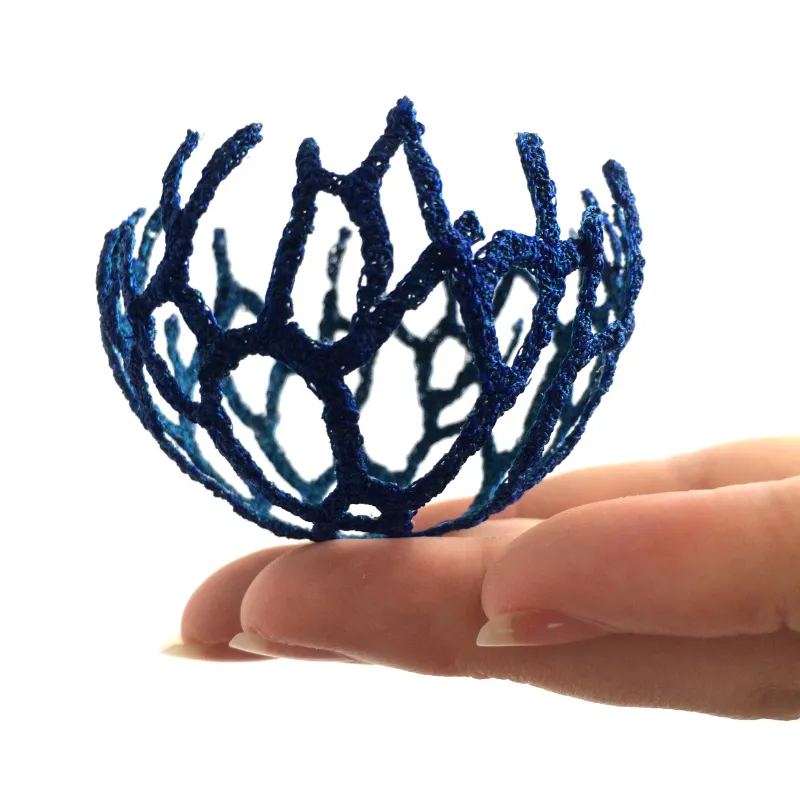
Gail: Regarding the thread that you use, do you have any particular preference for that?
Meredith: I tend to just use standard machine embroidery thread. I like a good quality polyester thread. Quality is probably more important than brand or type. But of course, you can use whatever thread you like because it’s like your medium, it’s like your paint or your pencil. So I quite like the luster of a machine embroidery thread and the vibrancy of the colors. So I tend to be drawn to that. But I’ve had many other students work with even just your standard cotton threads, beautiful wool threads, because they have different sort of surface properties and textures and ranges of colors. So there’s no one thread that you need. But, yeah, personally, I tend to just work with your machine embroidery thread.
Gail: I've seen some pieces of yours that have beautiful gradation of colour on them. How do you achieve that?
Meredith: Yeah, so again, like, I think I approach it the same sort of way as you would when you’re drawing. And that was something that I sort of found as a bit frustrating when I started doing this, because I came from this painting drawing background, where I was used to being able to mix up whatever colour I wanted and whatever tone or shade of a colour I wanted. And now I was restricted to the palette of the colours that threads came in. And I really didn’t like when you swapped from one thread to another, and it was a very jarring distinction.
So I really went out of my way to try and develop a way to blend the threads. And I found that by tweaking my tension and using different colours in my top and my bobbin, I was able to essentially get a blending, a mixing of my thread colours. It’s almost like a pointerlistic painting, where you have dots of different colours together, and then your eye blends it together when you look at it. And I sort of have a formula of swapping and changing my top and my bobbin thread so that I can transition between colours and get that smooth change. It’s something that I love to do in my work. And I think, yeah, like you said, it’s probably something that my work’s known for.
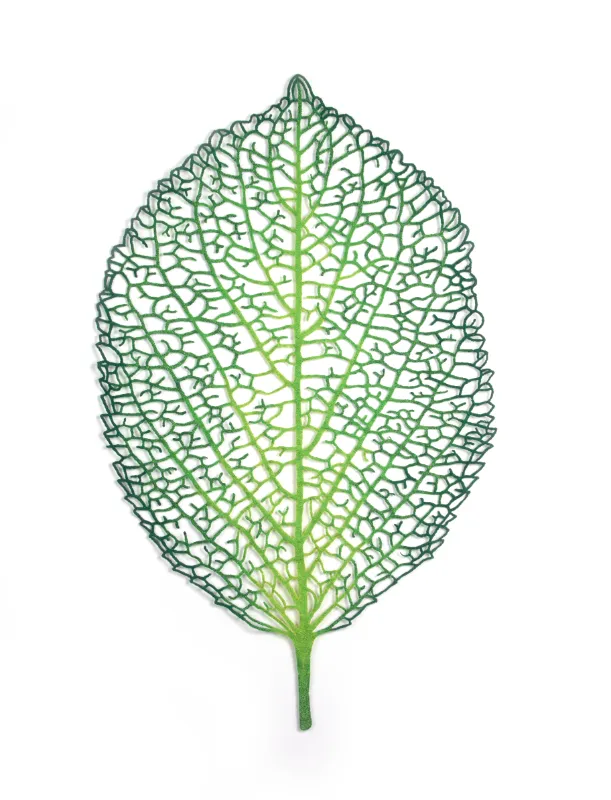
Gail: Absolutely. I mean, you really do achieve that change between colours so effectively and so smoothly.
Meredith: Well, thank you. I do love it. There’s nothing more satisfying than doing that. And another thing that probably works to that I found in my experimentations when I was trying to get this effect, I actually like how things blend on the underside of the embroidery rather than the top side. I find the way I tweak my tension, I get a better color blending effect that way. So any of the pieces of mind that you look at that have that gradation, you’re actually looking at the underside of the embroidery. So it looks very different on the top to the bottom.
Gail: Right. Okay. So do you have to keep taking it out and looking underneath, or how does that work when you're actually working with it?
Meredith: Yeah, well, every time I change a color, I’ll take it out and have a look. I tend to test my color blends first so I know how they’re going. And I think because I’ve been doing it for so long now, I know how it’s going to work unless something’s very wrong with my tension. And as long as I sort of follow my formula, I know the color blend is going to work. So, yeah, you just sort of get a feel for it over time. But yeah, you’re always checking. And you change colors a lot when you do work. So plenty just to flip it over and see how things are progressing.
Gail: Yes, I'm sure. Do you have one of those machines that changes the bobbin for you or you just have to do that manually?
Meredith: Is that a thing? I didn’t know that was a thing.
Gail: Apparently, that's a thing.
Meredith: Well, maybe, as I said, maybe in some of the more fancy machines. But no, you just get really good at rethreading, and it’s not a big deal. I tend to have them all ready to go and just kind of swap and change. It’s just part of the process. Yes.
Gail: I think if you can sort of relax and feel that's what it is, that's probably the best way to approach it, isn't it?
Meredith: Yeah, absolutely.
Gail: Do you actually draw out your designs beforehand? Do you have an exact design that you work to, or is there an element of sort of adding to it as you go along?
Meredith: It does depend on the piece that I’m working to. There’s always often a few little tweaks and changes that happen at the sewing machine. But on the most part, I do tend to have the designs all figured out and drawn up beforehand. I spend a lot of time getting the designs right, drawing them out, and often I find that process of doing that design with pencil and paper helps me to sort of identify any problem areas or things that aren’t going to work. And it’s much faster to sort of adjust the design on pencil and paper because I can rub it out than it would be at the sewing machine.
So most times, yes, I have a two scale drawing figured out. I’m happy with it before I sit down and sew. And then there’s the OD tweak. And obviously the placement of the color and things like that all happens at the sewing machine. But once I get down to the stitching part, it’s generally really like meditative coloring in, essentially.
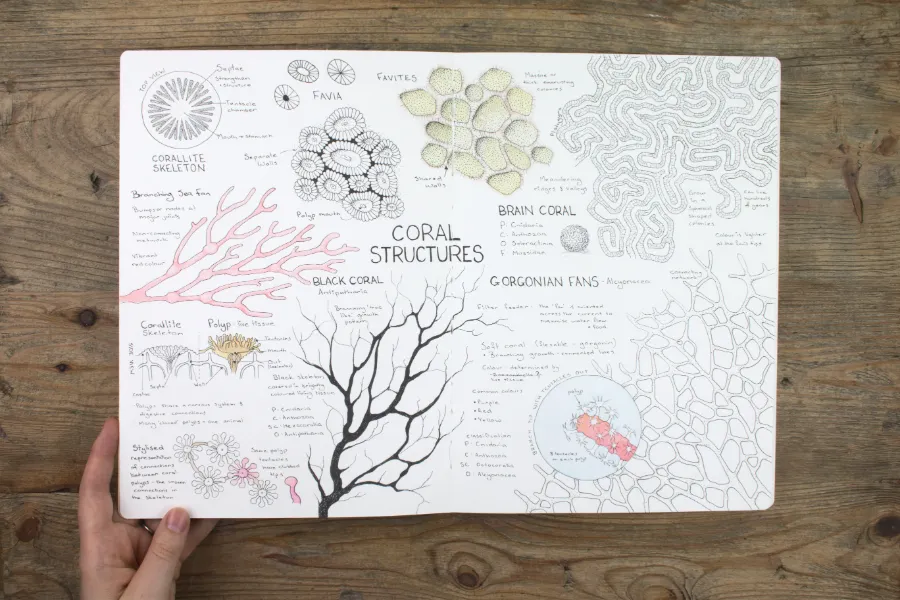
Gail: And do you transfer the design to the water soluble, or is that how you work with it, so that you've actually got it onto the water soluble in front of you?
Meredith: Yes, absolutely. So the water soluble fabric is still quite transparent. You can see through it, so you can easily trace onto it even a very large piece. I could just lay my water soluble fabric over my design, transfer it over, and then I’ve got my line works to follow at the sewing machine. Because you’re so focused on the part that you’re sewing, it’s actually I found quite difficult to draw completely freehand and not lose your way.
There are some pieces that I do. If they are like, repetitive shapes and designs I’m filling in an area, then I don’t need anything to sort of follow some of my designs, like pieces that are inspired by coral lights, which are very repetitive circular shapes that can all be done in the machine. But yeah, otherwise, I do really like to have lines to follow.
Gail: Yes. I think it stops any possible mistakes, doesn't it, occurring as you're actually you can switch off then, and just concentrate on sort of following the lines. Yeah. So could you tell us a little bit about what it is that you're currently working on?
Meredith: Sure. So, at the moment, I’m working on the last few pieces for my upcoming exhibition. So I’ve got a solo show in a couple of months, and it’s all about coral. If anyone’s familiar with my work, you’ll know that I’m quite obsessed with coral.
I’ve been stitching coral in various forms for well over a decade, and I still love it. So at the moment, the piece that I’m currently working on is a study of a particular genus of coral. I’m probably going to mispronounce it, but I think it’s anthagorgia. And I particularly like this coral because it’s got these sort of weird warty nobles all over it. And also, this particular genus does come in some phenomenal colours. Sometimes I take a bit of creative license with the colouring of my stitched interpretations of coral. But with this particular genus, corals come in many different colours, and this one does too, but it has this colour wave where it goes from this really vibrant yellow through to, like, a fuchsia pink.
If you didn’t see it in the real life, you wouldn’t think that was a realistic colour, and that was just too perfect for me to ignore. So I’m currently in a pink and yellow coral world, and I’m very happy.
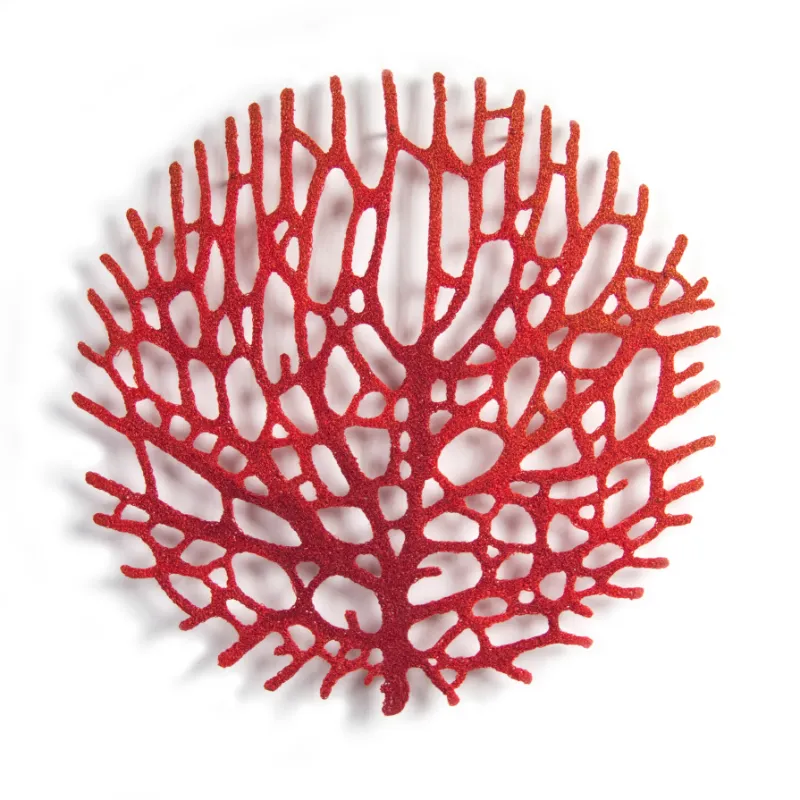
Gail: When you come to make up the pieces for an exhibition, are you sort of constantly considering, as you're working on them, how you might mount them up or frame them?
Meredith: Yes. With exhibitions in particular, you’re always considering how it’s going to look in the exhibition, how the pieces are going to relate to each other. So I definitely have series of works within the exhibition. Although the theme is coral, I’ve got a series of works that are all the same size or a series of works that are all the same stitched format. But all of my works, all of my embroidered works, are mounted and framed in the same way.
The way that I present my embroidery is probably just as iconic as my embroidery itself. I have a method where I sort of use pins and spaces to mount the embroidery so that it just sort of appears to float just a centimeter or so off the backing board, sort of like a delicate specimen, and it cuts beautiful shadows as a result. I actually call the process shadow mounting for that reason, so that’s always a consideration. Of course, when I’m designing any of my works, I’m thinking about how it’s going to be mounted and what size board it’s going to be mounted on, if it’s going to fit within a series, or whether it’s going to be a standalone piece. That’s its own unique style. And all of those things are going through your mind as you’re planning and as you’re building up the body of work.
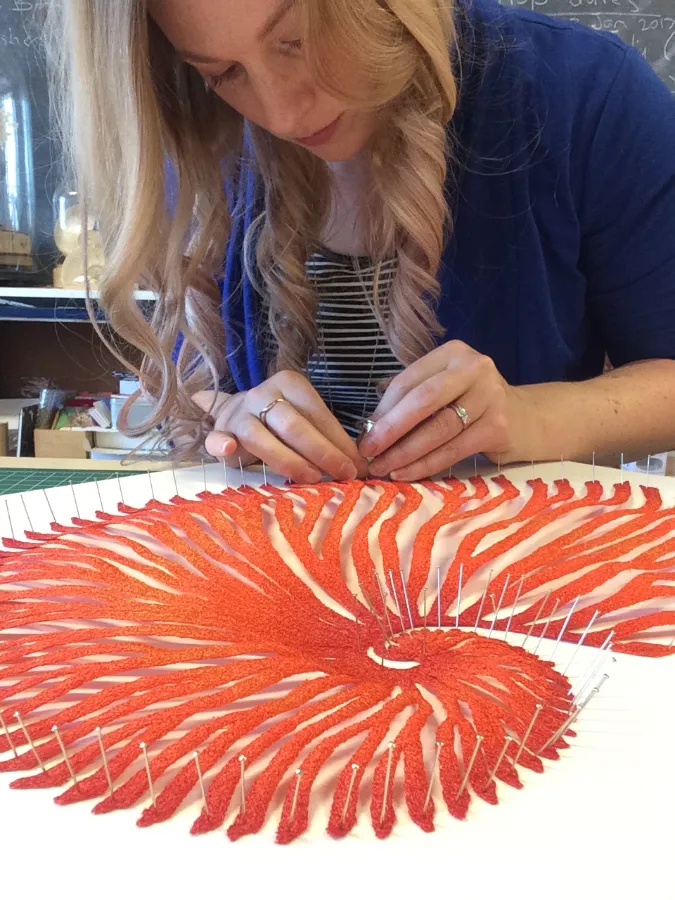
Gail: Yeah. Now, I can imagine, because you do have such an iconic and a specific style, how does that actually lend itself towards perhaps working to commission?
Meredith: Yeah, well, I think when people approach me for commission work, they already like my work, they already like my style. So generally, when people ask me for special works or commissioned works, they want something very much in keeping with what I already do. It’s quite rare for people to come and ask for something really out of left field.
Every now and then, I get a challenge, and sometimes really exciting, it pushes you in new directions and gets you to try new things. Earlier this year, I had a commission for a piece that was inspired by a Queen Anne’s lace, their beautiful flower, and it was lots of tiny, delicate white flowers. So with that piece, we went with a coloured background. My framing style is normally the colourful embroidery on white paper, white frame. It’s all very neutral. So it was really fun to work with a different coloured background. And it’s sort of a whole other world of possibilities. Even though you think, oh, changing the background is not that big of a change. But when you’re so ingrained in a particular style and your work is so recognized, not just for the work itself, but how it’s presented, sometimes it is very exciting to break the mold a little bit in that kind of a way.
Gail: I think sometimes when I speak to people, they either feel very enthusiastic about commissions or quite concerned, as you say. It's sort of pushing you out of your normal range, which can be, I don't know, I would imagine, very disconcerting.
Meredith: Yes, it can. I think it all comes down to communication, I think. So I have had the OD person that you can tell pretty early on, when someone approaches you whether or not it’s going to be the right fit and whether their ideas are going to align with your work. And I even have on I’ve got a bit of information about commissions on my website, and on that I do say one of the frequently asked questions is, do I ever say no to commissions? And I do quite clearly say, like, yes.
I will say no if I think something is beyond my skill level or if I don’t think I’ll be able to do that well. It’s outside the realm of what I know I can do well. I won’t take on the commission because at the end of the day, I want to be happy with the work, and most importantly, I want the collector to be happy with the work. So if I have someone approaching me, wanting me to do something like a dog portrait, that’s not my area. I’ve got no experience or skills in that area. I probably couldn’t do a very good job. I’m probably not the artist for that job. So there’s no shame in saying no to things. And I think if you make that clear to people from the beginning, you can kind of avoid some of those unpleasant or uncomfortable commission situations, I’m sure.
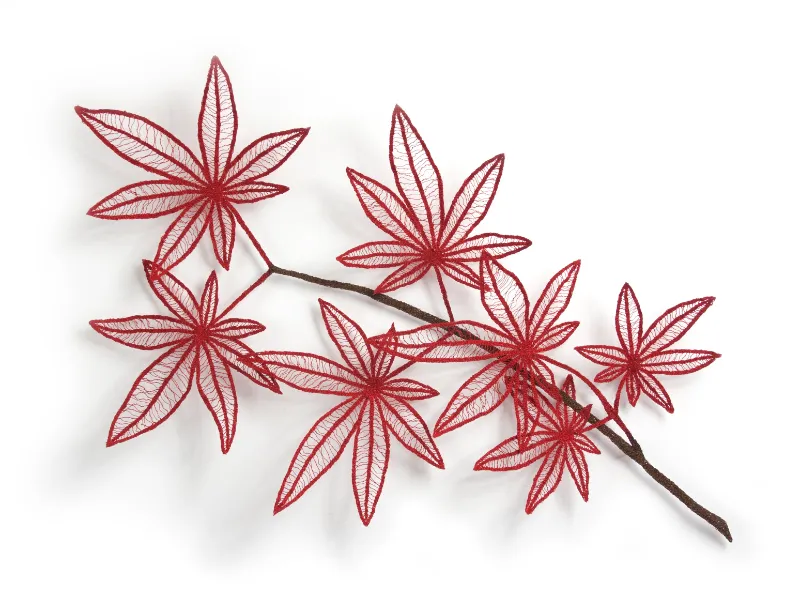
Gail: I think that sometimes people feel an obligation because someone's approached them to take that on. But it is all about trying to decide if you can make the best job you can and still feel happy with what you've produced, isn't it?
Meredith: Oh, absolutely. Yeah, absolutely. And everyone’s got their horror stories with their commissions. I’m sure I’ve had a few that have been more challenging than others, but I think on a whole, I’m quite lucky. And I think, like you mentioned, my work is probably quite distinctive. So if people approach me, they’re going to approach me because they like what I do and they’re going to want something along the lines of what I already do. So, yeah, not trying to go too far left a field.
Gail: So do you have people that are obviously waiting for the next collection to come out because they collect your work and they're waiting for the next piece they might add to their own collection?
Meredith: Yeah, so that’s one thing that, again, I’ve tried to be consistent with, sort of across my career. I sort of started off with pieces of a particular size, and I’ve continued to make pieces of that size and framed in the same size. Because I do have collectors who every time I sort of bring out a series like that, if they can or if there’s something that they like, they’ll get a piece, and then they keep adding it. So they have this sort of growing wall of my work, which is just amazing.
So, yeah, I do have things like that, and I do always have that in mind when I am developing work or collections. I do online releases. I’ve started doing those in the last few years and they’ve been amazing. It blows my mind because they sell out in minutes. It’s just crazy. And those are, again, always a consistent size. So people I do see the same collectors coming back again and again. And it’s sort of nice to think that my pieces are reuniting across the world with their friends from a few years ago.
Gail: What a lovely way of looking at it. So I assume you can never change the frames you use.
Meredith: Well, I could, but it would probably mess up both people’s collections, wouldn’t it? Yeah, I think I get all my pieces professionally framed and got that good working relationship with that framer. If that frame, that molding that they use, stops being made, or if my framer closes down, I might be in trouble. But it’s a pretty standard frame, I think I haven’t gone too crazy there.
Gail: So do you actually send your pieces away to be framed and the framer does them, or do you do them yourself?
Meredith: So I mount the pieces so the shadow mounting process that I use, so I get my embroideries and I mount them on the board so that they’re floating, and then, yes, then I send those boards off to a framer and they then frame them inside box frames. So there’s nothing fancy about the framer that I use. It’s just standard box frames, sort of shadow mounted frames.
But yeah, I get them all professionally framed rather than doing them in house, just because I just don’t have the time, energy and bandwidth to add framing to the list of jobs that I’ve already got. And they do a good job and it’s probably one of the most expensive aspects of making my work, of course. But I think it’s so important. It really sets it off well and very much a necessary step.
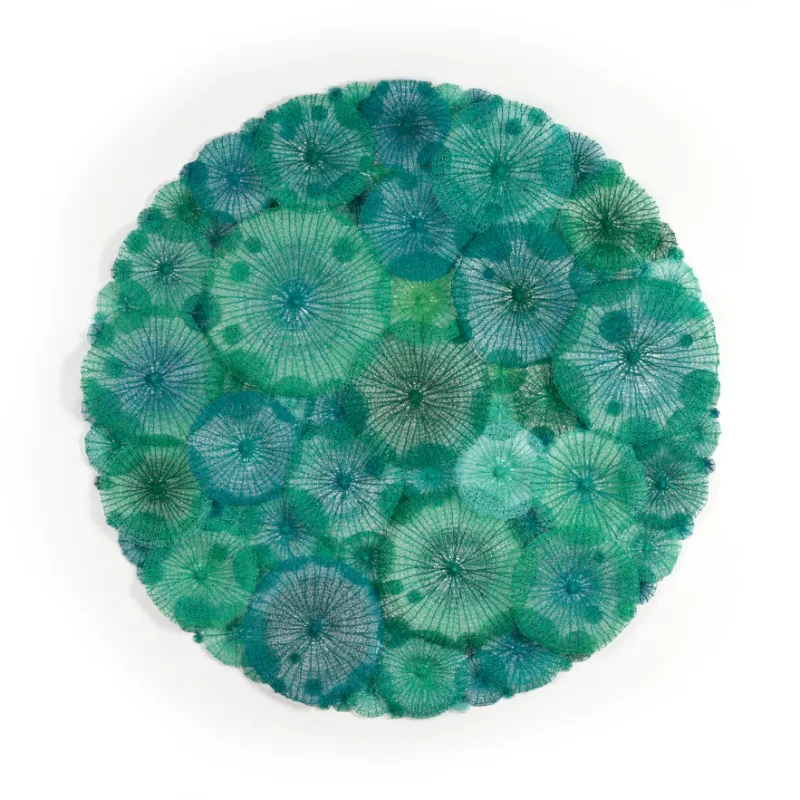
Gail: We have quite a number of students and people that will listen to this podcast that will be considering making a career in actually working to commission or producing pieces for sale. Could you give us any insight into how you cost pieces for a commission or for a gallery.
Meredith: Yeah. So I try and keep my pricing very consistent out of sort of fairness. I don’t just pick a number out of the air. The pricing has gone up over the years.
When I first started, it was actually quite difficult to price my work because there was nothing really like it out there. So I couldn’t really find a comparable artist to kind of base my prices on. So I just sort of spoke to other artists. And when I started off in group shows, as you do, you brainstorm prices and that’s your starting point, and then it sort of goes from there. So at the moment, I kind of have a formula, basically the size of the embroidery itself. I sort of figure out I think it works out at about $2, a square centimeter of embroidery. Or thereabouts.
A lot of my pieces are circular, so I figure out the surface area of that circle and then basically times it by two. I think that’s how the formula works. I’ve got it written down. I’m not that great at math, so I need to kind of go back and figure out the formula, and then it’s all sort of comparable. So my smallest works at the moment, my sort of mini range, they retail for 475 at the moment. Those are the pieces that I release in the online releases. So I actually include shipping in that price wherever it goes in the world, and then they sort of go up from there. I think if you’re starting out, what is probably more important than trying to figure out exact numbers is to have a range of prices.
You want to have things that are under $100 that are the mindless entry level, I just want to buy something from your products. And that doesn’t necessarily have to be an original artwork. An original artwork under $100. It’s hard to come by these days, but you could have other things that people could get so they could have a little piece of you.
So I’ve got things like books that I produce, and occasionally you could do prints and other merchandise, if that’s what you like. And then I think it’s good to have a range of prices of work. So then have between 100 and $500, $1,000 above and beyond, and depending on where you are and what type of work you’re doing as to how high up the scale you go. But I think having a range of prices is probably more important rather than agonizing over how to price a particular work.
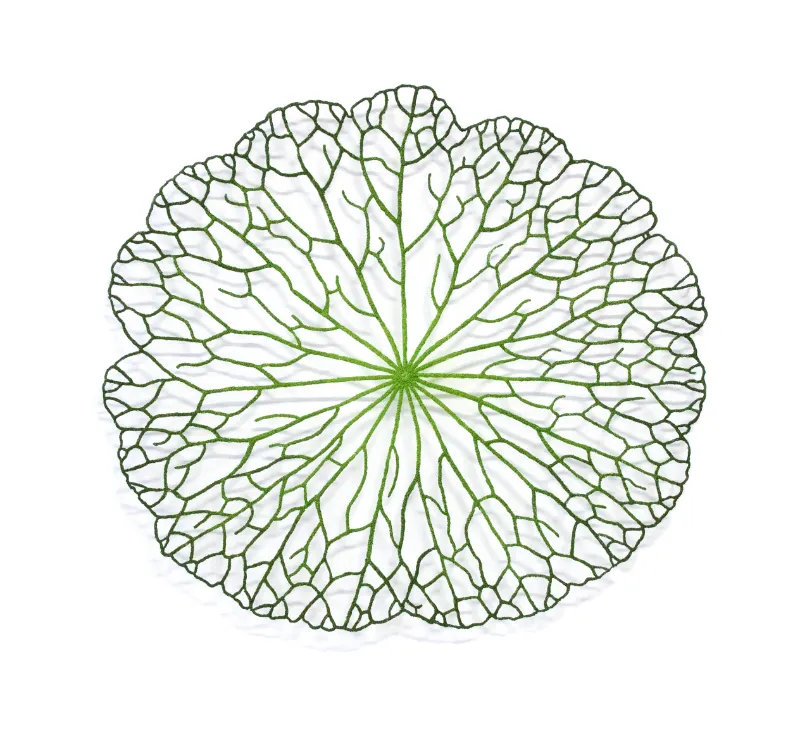
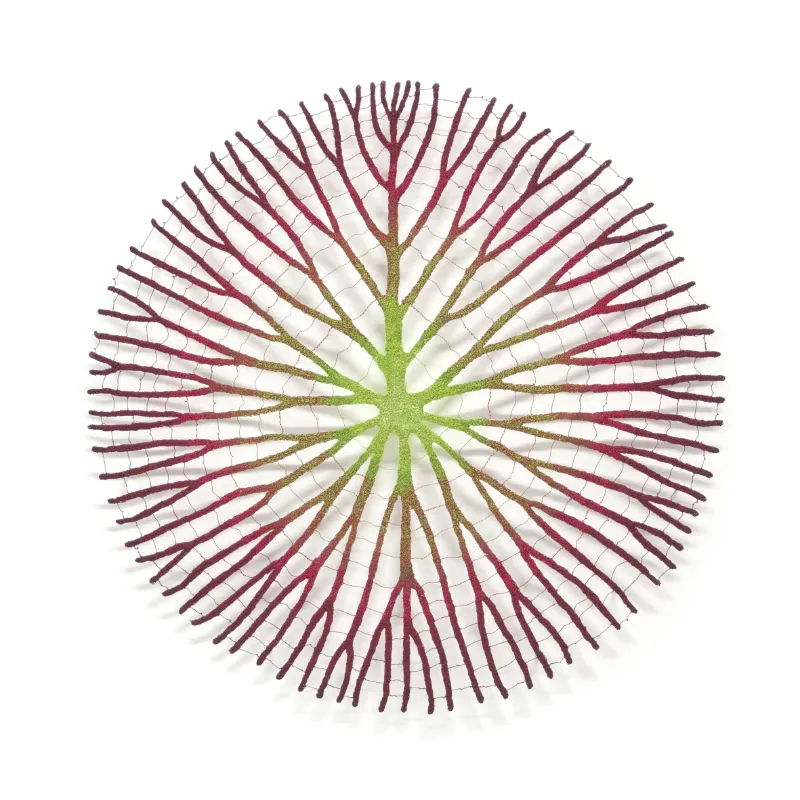
Gail: Yeah. So if you were going to, for example, the range under $100, presumably that would be something that had an image of your work on it rather than an actual piece. Maybe gift cards or something like that.
Meredith: Yeah, definitely. I’ve always found gift cards are fun. I tend to produce gift cards, and particularly at an in person exhibition. People might not be able to walk away with an artwork or their favourite artwork might have sold, but they’re quite happy to take away an arm full of cards. Things like that are always easy and very accessible nowadays. So, yeah, definitely cards, small prints, all of those kinds of things.
Gail: Do you do your own photography for those, or is that something that you would use a photographer for?
Meredith: No, I do my own photography, so that was something else that I sort of had to learn. So many things that you have to learn along the way. And you look at the early examples of my work and there’s still lots of images on the internet that are terribly photographed. Terrible lighting and everything. But once I sort of figured out the formula for how I photograph my work, because they are challenging to photograph, probably different than other artworks, because they do have that three dimensional quality. And I do want to have hints of the shadows in the images without having the shadows take over.
But once I figured out my setup and some basic editing tweaks, I now, like many things in my practice, I have the formula of how I do it. So my photographs are consistent and have been probably for the last ten years or so. Yeah, as a result, really good photographs are obviously hugely important, particularly these days, when so much of the work is viewed outside of in person, it’s viewed online, it’s viewed in print. You need to have good images of your work and you need to learn how to do that so you can communicate what you do well with others.
Gail: So when you talk about getting work ready for an exhibition, would that be an in person exhibition that someone could walk around? Or is it increasingly now more about an online exhibition?
Meredith: It’s a bit of both, really. It’s kind of a constantly changing atmosphere, isn’t it? So the exhibition that I have coming up is an inner gallery in person exhibition. You can come and see it, and while in many ways I probably don’t need to do that to sell the work, there’s probably enough interest for me to just make it and sell it online and then I wouldn’t have to pay gallery commission. But I quite like to have the goal of the exhibition to work towards, to produce the body of work. And it is really nice to sort of see it all. And there’s still a lot of people who like to visit the exhibition who like to see the real thing, and I think there’s something special about that. And I have so many people who comment they’ve followed me for forever, they’ve seen my images online, and then when they see it in real life, they’re like, oh, it’s so different in real life. It’s so much better, it’s so much different than I thought. It’s bigger, or whatever.
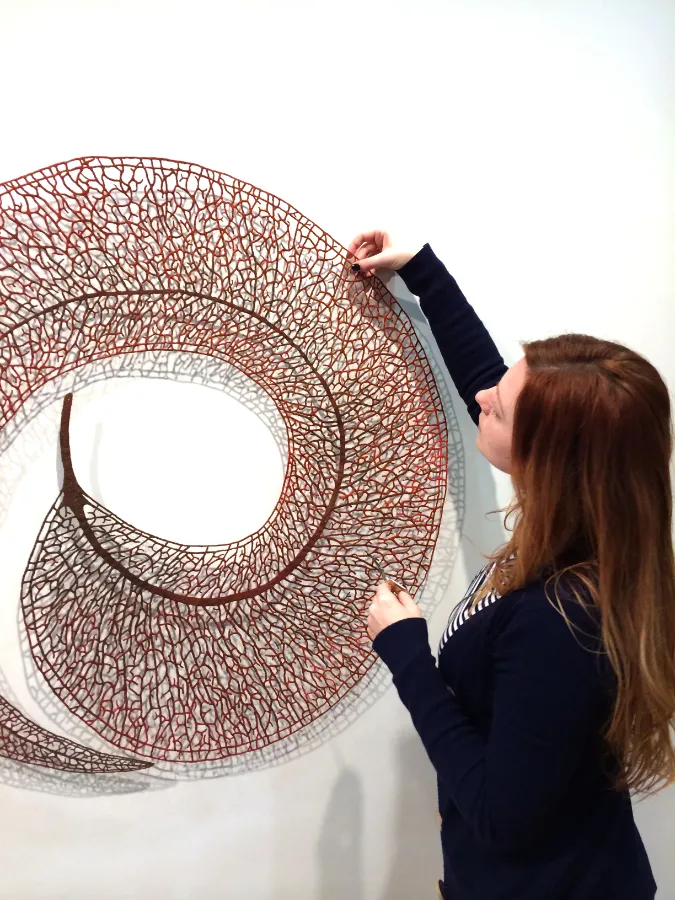
Gail: Yeah
Meredith: So that’s always really nice to hear. But there’s also so many people who can’t get to the exhibition. My upcoming exhibition is actually a fair way away from my house. It’s probably about 5 hours from where I live.
Gail: Oh Goodness.
Meredith: It’s not in a major central place. Not many people will get there. So it is also important, I think, to try and represent it online and try and share as much of the exhibition experience as you can with others, so they can kind of still feel like they’re there, even if they’re far away.
Gail: And then, of course, once someone buys, you have a job of shipping it out to them. I'm sure your pieces must have gone all the way around the world.
Meredith: They have, which is so nice to think. One other advantage of having the exhibition through the gallery is I’m not responsible for shipping. They do all of that. So when I do my small online releases, I do all the shipping. And if I sell a work through commission, of course I ship that. But yes, one thing that is nice about working with the gallery is they handle all that side of things at the moment.
Gail: That must be nice.
Meredith: I’m sure it is. A bit of stress out of it. Always worry until they arrive safely to the other side.
Gail: They're so delicate, aren't they? I would imagine that they need a lot of very careful packing.
Meredith: Yeah. Anytime you ship any artwork behind glass, you’ve just got to be really careful because if the glass breaks, it can ruin the artwork. But there’s ways to pack it. There’s professionals who know what they’re doing who probably do a much better job than me, I’m sure.
Gail: But as you say, having somebody maybe take over that, if it's a gallery, must be really useful. I know I speak to quite a number of people that feel very strongly that they still want to use galleries because they like having the galleries there. I suppose that if everything became an online transaction, there would be no need for them. And that would be a shame really, wouldn't it?
Meredith: Yeah, I think galleries definitely still have their place and it can be a really good relationship. It can be a really positive experience. So, yeah, I don’t think galleries are going anywhere because I still think that there’s people who really like the experience of going to a gallery, even if it’s not to buy work, just to experience and look at it and learn a bit about it.
Yeah, I think there’s still nothing beats seeing the real thing in person. I suppose these great masters, their work still travel the world and all these people flock to see them. There’s nothing really beats seeing it or seeing something that you’ve looked at in a book or looked at online and seeing it in person. But there’s a huge growing trend, of course, moving away from galleries and artists that are just completely online and people are becoming more comfortable with that way, which opens up many more opportunities for us as artists as well. It’s not a gatekeeper kind of situation anymore. We can kind of forge our own paths if we choose to.
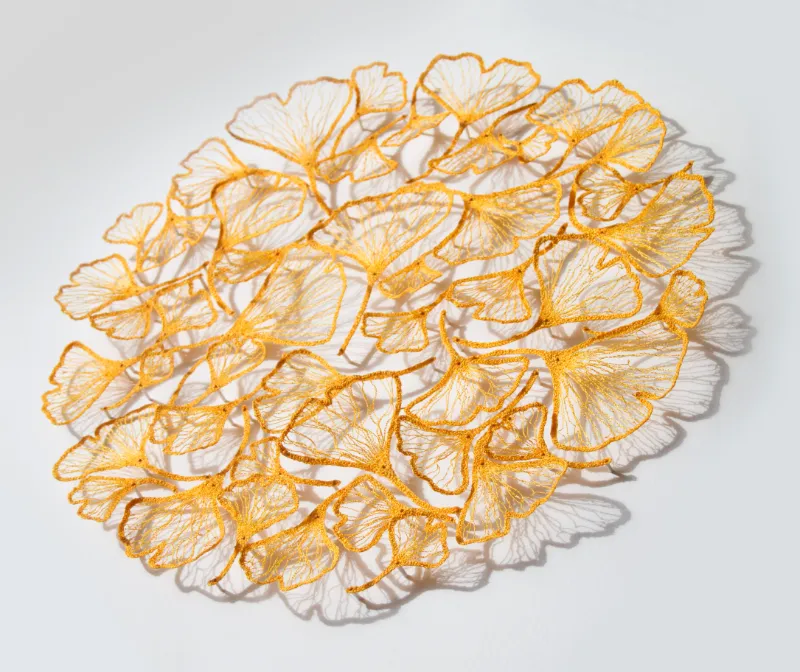
Gail: No, that's very true. I suppose a lot of that must have come about during well, during the Pandemic really, because we just couldn't get out to view things. Then a lot more went online, didn't it, during that time?
Meredith: Yeah, definitely. I think it forced a lot of people to go online and it also forced people to become really comfortable with doing all of these things online. You think about, my grandparents know how to use zoom and that would have never happened if it hadn’t been for the Pandemic. So, yeah, it forced everyone to pivot and go in different directions. I think a lot of possibilities and opportunities have come out of that. Absolutely.
Gail: Because you were very severely locked down, weren't you, in Australia during the Pandemic?
Meredith: We were, yes. They took it very seriously here. Thankfully the lockdowns didn’t affect me and my working life too know, I’m an artist, I work on my you know, thankfully we weren’t as affected as others, except for the fact that we couldn’t really travel far or see our families. I felt very lucky in that respect. But yeah, we had some pretty serious lockdowns here, that’s for sure.
Gail: Obviously it was a dreadful time globally, but certainly I've spoken to quite a number of artists and makers who actually found it to be a very productive time for them. Is that how you approached it?
Meredith: Yeah, absolutely. I actually think it was quite game changing for me because during the Pandemic as well, I started running online courses, and teaching is a large part of my practice and I was already working on that.
But of course, the Pandemic sort of forced it into reality a little bit sooner and also people were open to that type of learning because that’s all they could do. So that part of my business exploded and has been amazing ever since. So for me, it was a huge turning point in terms of the viability of my art business and everything, but yes, also just the opportunity to knuckle down and make and concentrate, try new things, experiment. You often don’t get the time to do that, particularly, I think once you’re working on commissions or regular works, you don’t get a lot of time to stop and to play, and it was quite a luxury.
Gail: Do you find that if you have to do a lot of work, such as producing for an exhibition, that you have to be quite careful with yourself over having breaks? Because I know with machine embroidery generally, it's quite hard, isn't it, on the back and the arms leaning over the machine for a long time.
Meredith: Yes, definitely. I’m actually quite glad you brought that up because it’s so important. Yes, obviously, you’ve got to make sure you’re very well set up. Ergonomically, and that’s also another reason why I work on a longer machine so much. Ergonomically, for me, anyway, I just find it so much better. It’s just I’m much at the better position. I’m not hunched over so I can see my work because I was getting all these horrible neck and shoulder pains, and I’m too young to have all of those things happening in a couple.
Gail: Of years of this type of work
Meredith: So, yes, having a good, ergonomic, set up is usually important, but like you said, also taking breaks and making sure you’re moving, making sure you’re exercising. And even though this is my full time job, I’m not in the studio every day. There’s admin days or there’s days I’ve got young children, there’s days where they’re not in care, and I’m with them. So my working week or my sewing week is broken up, so I’m not slaving away of a sewing machine 8 hours a day, even though sometimes I would like to.
Gail: Yeah, that would be very bad for your back.
Meredith: I think it would be. It would be terrible. So it’s all about balance.
Gail: Indeed. Yes. So what's next? I know obviously you're working towards this exhibition, but do you have other things, such as a book or anything like that, that's coming up in the future?
Meredith: Well, I’ve actually just brought out a new book, which is very exciting, brought out a couple of months ago. So my last solo exhibition, funnily enough, at the same gallery was something called the 100 Embroideries Project, like the name suggests I created 100 Embroideries, and I’ve just put together a book cataloguing that and just released that. So that was a big project for this year.
But yes, the exhibition and I’ve always got other things in the works. Although the focus of this exhibition is Coral, and I’ve been working with Coral for so long, so I do have plans to create another book in a similar format as the 100 Embroideries Project book, but focusing on Coral, this exhibition, and also all my past work in Coral. So that will be in the work probably next year when I have the time to focus on it. And I’m also looking at expanding some of the online courses that I offer, and I also just have a huge commission. Waitlist. I feel like I’ve been sort of putting that on hold while I focus on this exhibition, but I’ve got a lot of exciting, unknown work ahead of me, so that is the focus for the next little while.
Gail: It's good that you view it like that. Exciting. Sounds much better than I have to work my way through this list.
Meredith: Yes, you’ve got to enjoy it. Otherwise, why are we doing it?
Gail: What is it that keeps you on track and motivated? I just wonder if you've got any advice for our students, because it is quite difficult if you're having to produce work full selling on a regular basis. You can sometimes get either bored or fed up or just lacking in inspiration. How do you have any advice for how to combat that?
Meredith: Yeah, it’s definitely an important thing, isn’t it? So I think first and foremost, this is my job. Being an artist is it’s not just one thing. There are many things going on. There’s obviously the creating and making of the work. I also have the teaching side of things. There’s also the business side of things, the marketing. And now with social media, there’s a lot of content creation. So there’s lots of things that you’re doing and a lot of them are very creative in many different ways. Some are more step by step as well. So I feel like you’ve got to treat it like a job.
You’ve got to set aside days or blocks of time to work and be organized. If there’s any advice that I can give, it’s to try and be an organized artist. Because we have this horrible reputation as artists as being these all over the place, disorganized people, and you don’t have to be that way. Being organized is so important. Set yourself goals. I find having deadlines works really well. So obviously things like an exhibition, I have this exhibition, I’ve got this gallery to fill, so I have to make work and all of those sorts of things. Whatever works for you to keep you on task, find a system that works for you. And if you’re not feeling a certain way, you’re not feeling inspired to create work, there’s always other things that you can be doing that will move your business forward and move your work forward. So it’s this constant juggling act, I find. But that’s also one of the things I love about it. What you put in, you get out, you’re self employed, the work you do will make your job and your life better and easier. So just always be moving forward, really.
Gail: It's almost like having two jobs, isn't it? You have the one that you started with, which is obviously machine embroidery, that's most basic, or creating the art. And then you also have the running the business job and actually having the skill set to go from one to another can be quite challenging, I think.
Meredith: Yes, and I think it’s something that art school doesn’t often prepare you for. Definitely it didn’t prepare me for that, but thankfully I quite enjoy the business side of it. I quite enjoy sort of understanding it and streamlining it and being organized. I’m quite a logical person and I think that’s definitely helped me with that side of things.
I think you’ve got to learn to love the business side as much as the making side and find the joy and the creativity in that side rather than just the making, because you tend to spend just as much time on the admin and the marketing and all of that sort of stuff as you do in the studio creating. And that might be something that people don’t want to hear. They just want to think, oh, no, I’m just going to shut myself off in the studio and spend all my time painting or stitching or making and then everything else will just happen. And maybe that was the way more so with galleries when they were representing you. But I think more and more you need to take on the responsibilities of that side of things as an artist, if you want to make it and if you want to make it on your terms. So you’ve got to find a way to enjoy that side of it as well
Gail: Yes, I think otherwise you end up risking the possibility that you make an awful lot of art, but then don't sell any of it.
Meredith: Yes, that is true. You want to keep it moving. I guess that’s the difference, perhaps, between a profession and a hobby. And there’s absolutely nothing wrong with making work as a hobby and making work because you enjoy it. But if you want to make this your job and if you want to make a living out of it, yeah, you do need to be making money, you do need to be selling work. So you have to find ways to do that.
Gail: Absolutely. So I just wondered, sort of to finish off, do you have any sort of things that have happened during your career or any anecdotes that you'd like to share with us?
Meredith: Oh, now you’ve put me on the spot. It’s like there was a podcast I was on recently and they were like, oh, yeah, what’s your favorite film? I had no warning. And I was just like, you can’t ask someone something like that with no warning. Yeah, I’m just trying to think. Maybe I’m not that interesting.
Okay, well, if we’re going to try and think of funny little anecdotes or lessons, and I’m only thinking this because at this moment, my cat is trying to climb into my lap, as he does. Back when I used to work from home, I used to have a home studio. I don’t anymore because I need to go to work. I work much better away from home. But back when my cat was around with me, something that he would do quite often is he would go and have a drink from the shower, as he does, because he can’t drink from a bowl like a normal cat. He has to drink from the shower and then he would come and he would walk across my work. And of course, my fabric is water soluble, so when a cat with wet paws walks across your work, he leaves gooey holes in it.
And I’ll tell you what, he’s lucky he’s cute because I would have thrown him out the window several times the number of works he made more challenging for me, but that’s one of the reasons why, yes, I now have a studio away from home, away from the cat. He also likes to sit on the top of my sewing machine when I work. He’ll climb up on the top and then try and come in for a cuddle. I used to think he used to time it. It was almost like he knew when I needed to take a break. We were talking about taking breaks earlier. The cat was very attuned to when I needed a break. If I sewed for over an hour or so, it’d be time for a kitty cat cuddle. So, yeah, that’s one thing I do miss.
Gail: That's obviously the answer to taking a break, isn't it?
Meredith: There you go. You just need a cuddly cat to come and sit on your machine and stare at you until you need a break.
Gail: Meredith, it has been absolutely lovely talking to you. I've really enjoyed our chat today and I'm sure that other listeners will as well. Thank you so much for taking the time out of what I know is a busy day for you and also actually for sort of staying up into the evening to do it, because there is a bit of a time difference.
Meredith: There is no I appreciate you allowing me to do a late night podcast on my side. It’s always tricky to line up these international ones, but I really appreciate it. Thank you for having me. It’s been really good fun
Find out more
Exhibitions:
For details about exhibitions please visit Meredith Woolnough’s website.
You can follow and connect with Meredith by checking out her website or on Instagram.
Don’t forget to check out Meredith’s book, Organic Embroidery, which is featured on our list of Latest Book Releases – perfect for Textile Enthusiasts.


